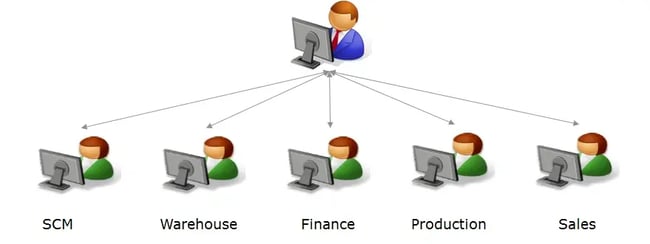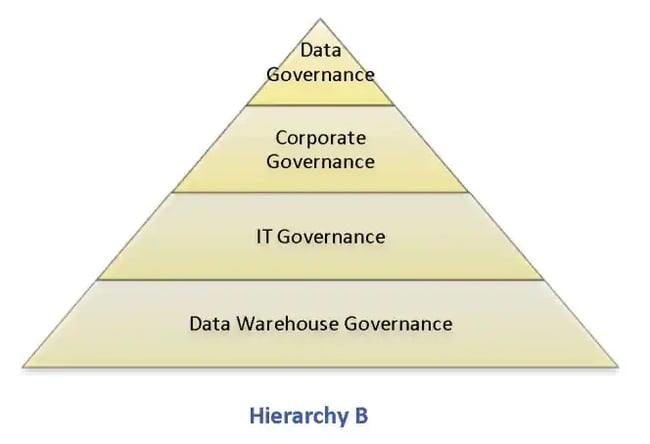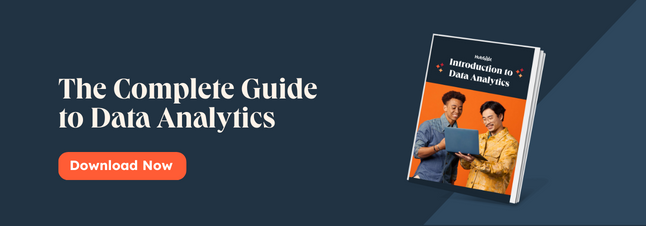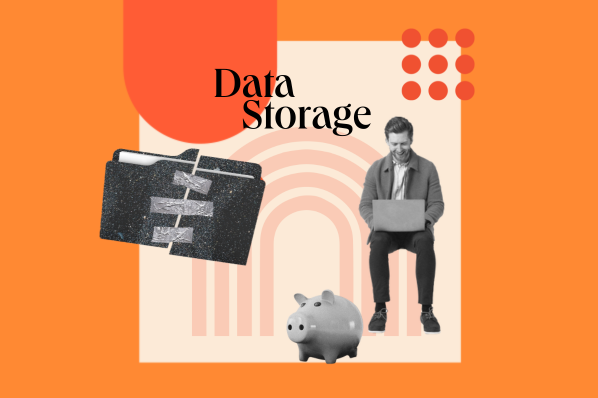- Data Governance vs Data Management
- Data Governance Examples
- Data Governance Models
- Data Governance Framework
- Data Governance Best Practices
- Data Governance Tools
What is data governance?
Without data governance, data can become unreliable or invalid and pose a significant threat to your organization. Or, data may not be easily available, which will affect employees' day-to-day workflows. In a survey by McKinsey, respondents said that 30 percent of their total enterprise time was spent on non-value-added tasks because of poor data quality and availability — and this percentage varied by department or role.
 Worse still, if the data becomes completely unusable, data collection will have to start from scratch.
Worse still, if the data becomes completely unusable, data collection will have to start from scratch.
Let's take a closer look at the reasons businesses need a data governance strategy.
Why Businesses Need Data Governance
Businesses use data governance to get the most from customer data.
By obtaining data about your customers, employees, finances, and more, and making sure it's used effectively and efficiently, you can provide your employees with easy, reliable access to information that helps guide major business decisions.
Being able to quickly review information and make informed decisions based on real-time metrics not only minimizes risk — it also helps your company capitalize on timely upselling and cross-selling opportunities.
Implementing data governance ensures customer data safety, as 87% of respondents in a McKinsey survey wouldn't do business with a company with security concerns and 71% would stop if sensitive data was given away without permission.
Considering all these benefits, it makes sense that the Data Governance Market is growing. According to data from Mordor Intelligence, it was valued at 1.81 billion US dollars in 2020 and is projected to be worth 5.28 billion by 2026.
Data Governance vs Data Management
Data governance is often used interchangeably with the term data management, but these are two distinct ideas.
Data governance is more about documentation. It outlines who has ownership of a company's data, who can access the data, what data sources exist, and what measures are in place to make sure data is secure and compliant with regulations.
Data management is more about action, or executing on the rules and policies outlined in the data governance strategy.
To learn more about what data governance is, why it's important to virtually all businesses, and how its different from data management, check out this video by The Career Force:
There are many types of data governance that fall under its overarching umbrella. Let's take a look at a few of these examples in the section below.
Data Governance Examples
Data governance is not just one thing. It's all the processes, policies, standards, and roles that help ensure data is usable, easy-to-understand, secure, high-quality, integrated, and preserved. When it has all these attributes, it is known as "governed data."
Let's take a closer look at the different purposes of data governance below.
1. Data Usability
If you want your employees to use your data, it needs to be accessible and easy to understand. Data should be stored in one location and organized in a simple, logical way. Additionally, every employee in your organization should understand what each piece of data means, how it's collected, and how to use it.
Below is a screenshot of a HubSpot CRM index page. This index page pulls all relevant data into a single space for the user. Saved views on the index page further organize the data in ways that are obvious and contextual to the users that engage with the data. This index page provides an example of data usability in action.
2. Metadata
Metadata is qualitative information that describes the other data you've collected at your business. It helps your team understand why certain data is collected as well as it's relevance to their short- and long-term goals. This way, if data is ever misplaced or forgotten, you'll have context clues to explain the purpose of each dataset.
In the next image you can see how metadata is found in the HubSpot Smart CRM. Property descriptions help not only set guardrails to data entry, but also clearly indicate to users why data has been collected and how they should use it.
3. Data Security
While most of your data should be easily accessible, some information will be extremely private and need only be viewed by specific employees. In this case, data security is essential to protecting data and deciding who should have access to it. This comes in handy particularly with information pertaining to payroll or finances.
A common implementation of data security comes in the form of user permissions. User permissions allow your business to control not only what data users have access to, but also what content and processes they can partake in.
4. Data Auditing
After defining access to data amongst your users, your team should also create processes for analyzing and validating actions taken against that data. By regularly auditing data, your team can gain valuable insights into the reliability and relevance of your data, allowing you to make informed decisions and take proactive measures to address any risks.
4. Data Quality
One of the most important aspects of data governance is making sure your data is reliable and consistent. If not, your team may make misinformed decisions that end up costing your business a fortune. Consistently checking data for accuracy can help you filter out incorrect, out-of-date, or corrupted information.
Setting property rules is a key step in ensuring proper data quality. These rules narrow what data inputs are acceptable from users and other sources, resulting in a database that is actionable and accurate.
5. Data Integration
Sometimes, data coming in from a variety of sources needs to be combined. In these cases, data integration groups this information into a larger dataset that provides meaningful insights about your business. By combining data together, you can obtain a clearer picture of how different functions relate to each other within your organization.
6. Data Preservation
Your company should have a process for deciding how data is stored and preserved. After all, some data is used constantly, while other information can be archived, or even deleted. This is where it helps to have a universal storage system to ensure pertinent data is never too hard to find.
There may even be cases where automation is needed to remove or classify data in real time.
Data Governance Models
There are several data governance models that can be adopted based on your business needs and the types of data governance you use. Let's take a look at a few of these models below.
1. Decentralized Execution for Individual
This model is perfect for an individual business owner who manages and maintains all of their data. In this model, the same individual who creates and sets up their data is typically the only one who uses it. We can see how this model plays out using the image below.

2. Decentralized Execution for Team
This model is designed for business owners who manage and maintain their master data, with data being used and shared by employees across different teams. This ensures that information is categorized and distributed to every person on the team, especially in businesses with multiple offices or stores. Check out the image below to see how this model works.

3. Centralized Governance
In this model, a business owner or leaders control the master data and its creation based on requests from other departments. Data is centralized to team leaders for distribution within the company. This is effective for large companies that need to regulate internal information sharing.
4. Centralized Data Governance and Decentralized Execution
The final model combines aspects of the systems listed above. It involves an individual or team controlling the master data while each team creates their own datasets to contribute information. This streamlines data collection and sharing, making it ideal for larger businesses and their management teams.

Now let's discuss best practices for creating a data governance framework.
Data Governance Framework
If your team invests in data governance, it can provide your organization with continuous customer insights. The steps below outline what your business needs to do to create a successful data governance strategy.
1. Set a team goal.
Defining clear goals and metrics is crucial in creating a data governance framework. It helps identify valuable data and ensures everyone is working towards a common goal with measurable progress.
2. Adopt a data governance office.
After setting goals, assemble a team including management, data stewards and liaisons, and other stakeholders involved in data acquisition and security. This team, known as the "data governance office," will make critical managerial decisions.
3. Determine a data governance model.
Create a data governance model to determine who can view and distribute different types of data. This ensures that sensitive data is only accessed by trusted employees and not shared without authorization.

Source: TDan
You should also describe your rules and regulations for data collection. Outline your standards for securing data as well as which channels you'll use to obtain it. This will create consistency in your data collection which will lead to more reliable and accurate takeaways.
4. Create a distribution process.
The last step in data governance is determining how to distribute sensitive data. A reliable process and defined channels for distribution will foster smoother communication.
Data Governance Best Practices
The steps above should provide your business with a fundamental framework for data governance. If you really want to take it to the next level, check out the best practices for managing your data below.
1. Start with a small sample size.
Instead of starting with a complex or long-term project, it's best to begin with a smaller, more manageable one, like analyzing data for one team. Assess the state of the data, including its collection, storage, and usage, before deciding how much budget to allocate to the initiative.
2. Create a team dedicated to your program.
To ensure effective data governance, create dedicated roles within your program. The leader should have strong communication skills to convey its importance to the company. Each team member should have clear responsibilities to ensure smooth and efficient governance initiatives. The data governance office should consist of employees who excel in managing customer data and can independently determine the best process for organizing information.
3. Set clear goals for data governance.
Set actionable goals for your data governance program to ensure long-term success, such as protecting top-level data, reducing team friction, lowering data management costs, and improving data entry speed with a clear roadmap to success.
4. Be transparent with external stakeholders.
Inform external stakeholders about your data governance program prior to implementation to prioritize the security and validity of your company's data.
5. Integrate data governance into every department.
To gain stakeholder buy-in, integrate the data governance framework into every department, ensuring consistent data collection and providing insights for marketing, sales, customer service, and product development teams. For example, the data governance office can inform product management about consumer behaviors and usage reports, influencing product updates and improving productivity across the organization.
6. Create risk milestones.
When creating a data governance framework, consider potential risks to customer data security as it is shared within your organization. Risk milestones highlight these risks during data sharing and movement. This helps your team avoid costly setbacks that can negatively influence customer relations.
7. Assess projects after completion.
After each data governance project, assess its success and make necessary adjustments for future initiatives. Test the data, discuss with your team, and streamline or readjust processes accordingly.
8. Consistently refine your data governance framework.
As your business evolves, adapt your data governance framework to accommodate organizational changes and prevent oversight of customer data or accidental leakage of sensitive information.
Data Governance Tools
Once you have a data governance framework in place, consider which tools will help you accomplish your goals. Do you need a tool to help improve collaboration between teams, or a tool that will speed up the data entry process, or an all-in-one solution?
Here are some of the best data governance tools on the market.
1. Egnyte
Best for: Multicloud businesses

Egnyte is the only unified cloud content governance platform in the market. It enables multicloud businesses to get 360-degree insight into their content across devices, apps, and repositories. This makes Egnyte ideal for a range of purposes, including collaboration, data security, compliance, and threat detection.
2. IBM Cloud Pak for Data
Best for: AI-driven businesses
 The IBM Cloud Pak for Data is specifically designed to empower your organization in discovering, organizing, analyzing, preparing, sharing, and safeguarding data within complex and extensive enterprise ecosystems. With its ability to enhance data accessibility, automate tasks, enforce comprehensive data and usage policies, and more, IBM's solution serves as an invaluable tool for streamlining the development, implementation, and responsible scaling of artificial intelligence in various business operations.
The IBM Cloud Pak for Data is specifically designed to empower your organization in discovering, organizing, analyzing, preparing, sharing, and safeguarding data within complex and extensive enterprise ecosystems. With its ability to enhance data accessibility, automate tasks, enforce comprehensive data and usage policies, and more, IBM's solution serves as an invaluable tool for streamlining the development, implementation, and responsible scaling of artificial intelligence in various business operations.
3. SAP Master Data Governance
Best for: Enterprise companies
SAP Master Data Governance offers you the flexibility to govern your data in two distinct ways. Firstly, you have the option to decentrally own and consolidate your data across your enterprise system landscape. Alternatively, you can choose to centrally create, modify, and distribute master data throughout your landscape. This powerful tool enables you to streamline your databases, implement bulk changes, evaluate the impact of your data governance processes, and establish, validate, and monitor rules for data quality.
4. Lyftrondata
Best for: Companies on a budget
 Lyftrondata comes with a built-in enterprise data governance framework so you can ensure your data is accurate, up-to-date, accessible, and secure. To enable data governance, Lyftrondata offers features like data catalog, data model, data definition, data lineage, tagging, and enterprise data dictionary search.
Lyftrondata comes with a built-in enterprise data governance framework so you can ensure your data is accurate, up-to-date, accessible, and secure. To enable data governance, Lyftrondata offers features like data catalog, data model, data definition, data lineage, tagging, and enterprise data dictionary search.
This tool offers several pricing plans, including a monthly plan where compute is shared across multiple customers and Lyftrondata is deployed on a managed shared cloud instance. This makes it one of the most affordable data governance tools on the market.
Let governed data accelerate your business growth
Governed data — or data that is managed and secured by a specific department in order to ensure employees are only using credible and trustworthy data — can improve your company's efficiency, collaboration, and customer trust. Start leveraging these benefits by implementing a data governance framework today.
Editor's note: This post was originally published in June 2019 and has been updated for comprehensiveness.


-2.webp?width=650&height=253&name=The%20Straightforward%20Guide%20to%20Data%20Governance%20(DG)-2.webp)









